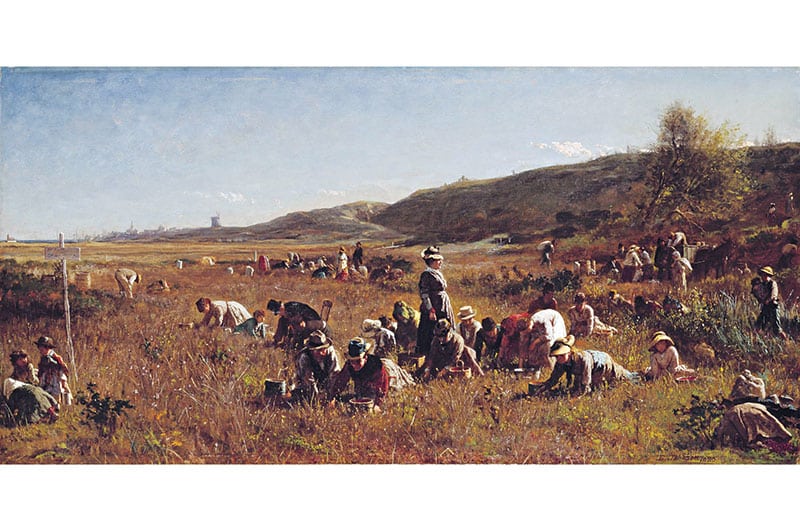~ by Amy Jenness, author of On This Day in Nantucket History, available at Mitchell’s Book Corner ~
A September 11, 1915 article in the Inquirer & Mirror announced that cranberries harvested from island bogs would now be shipped in barrels labelled “Island Brand.” The new labels would also include a map of the island which the writer noted would be excellent advertising for Nantucket. For several years prior, Nantucket cranberries had been shipped all over the world in barrels marked “Cape Cod Cranberries.”
Cranberries have always grown naturally on Nantucket, as do their cousin the blueberry. Native Americans harvested the tart berries for both culinary and medicinal purposes and may have taught the English settlers how to use them. The wet bogs where cranberries like to grow helped sustain islanders during the American Revolutionary War and the War of 1812, when all trade with Nantucket was prevented by both the British and the Patriots. Islanders were close to starving by the end of both those wars, and Nantucketers harvested what they could from the land and sea and kept themselves warm by burning peat from the bogs.
The first commercial cranberry operation started on Cape Cod in 1814, and by the 1820s cranberries were being shipped to Europe. But it would not be until 1857 that people grew them commercially on Nantucket. In 1880 well known painter Eastman Johnson famously captured Nantucket citizens harvesting wild cranberries in his painting “The Cranberry Harvest On The Island of Nantucket.”
At the turn of the twentieth century, commercial growers in southeastern Massachusetts debated and rejected expanding their operations to Nantucket. Finally in 1904 William T. Makepeace, the largest cranberry grower in the state, along with several others, planted cranberries on a 10-acre Nantucket plot on the island’s eastern end near ‘Sconset. They were skeptical, Makepeace later told a reporter for the New Bedford Standard Times. But by 1914 Nantucket was home to the world’s largest contiguous cranberry bog near located Gibb’s Pond. The company was harvesting 8,000 to 10,000 barrels of cranberries a year from 300 acres. Makepeace and his partners had discovered that Nantucket was an ideal place to grow, owing part to the naturally wet and boggy valleys of the island’s moors.
The berries were always picked in the autumn, after they turn a deep red color. The bogs were flooded with water so the ripe berries will float and the harvest was very labor intensive. For a short time each fall migrant farm workers from different parts of the world came to Nantucket to harvest cranberries. The painstaking work of picking by hand (at $1.60 a bushel in 1896) slowly gave way to mechanized methods such as using a scoop (workers were paid 25 cents an hour using the scoop) and later a scoop with metal teeth that combed through the low tangled cranberry vines with ease.
In 1916 the Nantucket Cranberry Company was the first in New England to harvest berries using a machine, which proved faster and more efficient than picking by hand. The machine was invented by Nantucket Cranberry Company president Horace B. Maglathlin. Growers from all over New England took note of Maglathlin’s machine, nicknamed the “horse-picker.” Maglathlin, a resident of Kingston, Massachusetts, received a patent for his machine the following year.
The Nantucket cranberry operation was part of a cooperative of growers in Southeastern Massachusetts who produced two-thirds of the nation’s cranberry crop by 1914. Every grower received a share in the company and their success grew tenuous during World War I, when a sugar shortage prevented food manufacturers and home cooks from making cranberry products for Thanksgiving. By 1930, three large Massachusetts cranberry growers merged to form the Ocean Spray cooperative, which is still in business today.
For much of its history of commercial growing, the supply of cranberries has exceeded the demand for them, which has resulted in very slim profit margins and extreme competition among growers. The business was further hurt by a 1959 contamination recall by the federal government when that year’s crop was tainted by the herbicide aminotriazole. Suffering from the loss of millions of dollars, growers learned to rebrand by creating new products like cranberry apple juice and by promoting cranberries at all times of the year, not just during the Thanksgiving holiday.
A 1962 federal marketing order stabilized the volatile cranberry market by coordinating supply and demand, although the problem of oversupply still plagues growers.
On Nantucket the cranberry bogs changed owners many times until 1969 when island residents Roy Larsen, Walter Beinecke Jr., and Arthur Dean purchased them, along with more than seven hundred acres of undeveloped land surrounding it. The men gave the land to the Nantucket Conservation Foundation (NCF) so that the NCF could generate income from the bogs. Today, the NCF cultivates twenty-four separate cranberry bogs totaling 195 acres and produces nearly 2 million pounds of cranberries every year. Part of the yield also comes from the NCF’s organic operation at the Windswept Bog.
The Nantucket Conservation Foundation celebrates the cranberry harvest with a free one-day festival: this year it will be held on Saturday, October 10 from 11 am to 4 pm at the Milestone Cranberry Bog, 220 Milestone Road.

